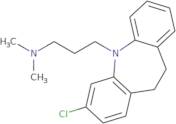
Product Information
- 10,11-dihydro-3-chloro-5-(3-(dimethylamino)propyl)-5H-dibenz(b,f)azepine
- 206-144-2
- 3-(3-chloro-10,11-dihydro-5H-dibenzo[b,f]azepin-5-yl)-N,N-dimethylpropan-1-amine
- 3-Chloro-10,11-dihydro-5-(3-dimethylaminopropyl)-5H-dibenz[b,f]azepine
- 3-Chloro-5-[3'-(dimethylamino) propyl]-10, 11-dihydro-5H-dibenzo[b,f]azepine
- 3-Chloro-5-[3-(dimethylamino)propyl]-10,11-dihydro-5H-dibenz[b,f]azepine
- 3-chloro-10,11-dihydro-N,N-dimethyl-5H-Dibenz(b,f)azepine-5-propanamine
- 5-(g-Dimethylaminopropyl)-3-chloroiminodibenzyl
- 5H-Dibenz(b,f)azepine-5-propanamine, 3-chloro-10,11-dihydro-N,N-dimethyl-
- 5H-Dibenz[b,f]azepine, 3-chloro-5-[3-(dimethylamino)propyl]-10,11-dihydro-
- See more synonyms
- Anapramine
- Chlorimipramine
- Clomicalm
- Clomipramin
- Clomipramina
- G 34586
- Nsc 169865
Clomipramine is an antidepressant drug that belongs to the class of tricyclic antidepressants. It has been shown to increase serotonin (5-HT) concentrations in the brain and may be effective for the treatment of depression, but it also has a number of side effects. Clomipramine is used as a research tool to study 5-HT pathways and its effects on other neurotransmitters such as norepinephrine and dopamine. The reaction solution is added to a vial containing clomipramine, which will react with the reagents in the vial to produce a colorimetric response. This method can be used to analyze drug interactions, treatment trials, or structural analysis of drugs. Clomipramine binds to 5-HT receptors and blocks neurotransmitter release from these receptors, which may lead to antidepressant activity.
Chemical properties
Technical inquiry about: 3D-AAA30349 Clomipramine
If you want to request a quotation or place an order, please instead add the desired products to your cart and then request a quotation or order from the cart. It is faster, cheaper, and you will be able to benefit from the available discounts and other advantages.





